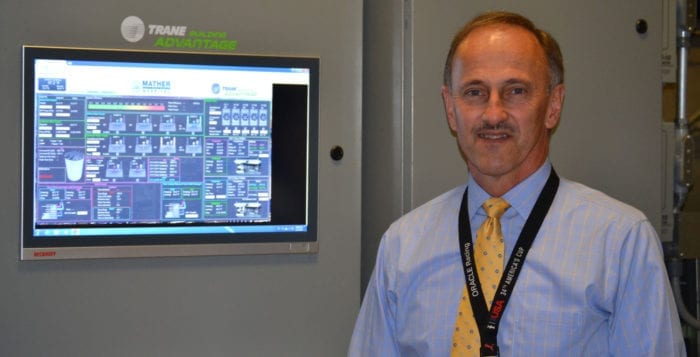Port Jefferson hospital a model for “green” initiatives

A Port Jefferson-area hospital is setting trends in reducing its environmental impact. A number of new initiatives at John T. Mather Memorial Hospital have turned the facility into an energy efficiency machine, but the hospital’s director of engineering, design and construction said they’re not done trying to improve.
“I would say Mather is one of the most progressive hospitals on the Island in terms of green energy renewable technology and reducing carbon footprint,” Brian Hassan, PSEG Long Island lead account manager for health care, said in a phone interview. He added if other hospitals followed Mather’s lead it would be beneficial to reducing substantial carbon footprint that can be left by facilities that consume large amounts of energy. The glowing assessment can be attributed in large part to the efforts of Kevin Koubek, the engineering director at Mather who is constantly working to improve the hospital’s efficiency.
“I think we’ve shown we’re trying to do everything physically and humanly possible to reduce our demand on the grid,” Koubek said in an interview. Between air conditioning and heating, heavy-duty medical equipment, elevators, kitchen equipment, lighting, gift shops, coffee shops and various waiting rooms, the amount of power required to run a hospital is obviously substantial. Koubek said the hospital is always looking for ways to reduce energy requirements.
“Trying to offset some of this electrical demand is huge, and that’s one of the reasons we have tried to identify where we can minimize our loads,” he said.
Mather is the first Long Island hospital to install a thermal ice storage system to help with cooling the hospital during warmer months. It was installed and became operational earlier in 2017. The system serves to shift a portion of the hospital’s peak electrical load from daytime to nighttime, when electricity is more plentiful, less expensive and generated more efficiently by creating ice using larger air conditioning equipment during off-peak hours, then storing ice in 24 tanks that are used with pumps to generate cool air during the day.
“The day-to-day benefits would be that we’re not turning on this large machine, we’re pulling off the electric grid,” Koubek said.
In the past, before the hospital focused on energy efficiency initiatives, Koubek said much like homes in the summertime, the hospital’s cooling systems had a hard time meeting demand.
“We have to recognize [we] do have patients that for whatever reason, they’re here,” he said. “Their comfort is paramount.”
The chiller was approximately $2 million, though the hospital is expecting a rebate check from PSEG Long Island to cover half the cost.
Mather was also the first Long Island hospital to install solar panels. A 50-kilowatt photovoltaic ground-mounted solar panel was installed in the rear of the parking lot in 2011, and Koubek said the hospital has considered adding more.
“[Hospital administration] would love to do that, it’s just very expensive,” he said.
Koubek added the hospital is also in the process of replacing about 300 standard lighting fixtures of the roughly 3,000 at Mather with LED ones. Standard fixtures require about 180 watts of power while LEDs require about 30 watts.
“That’s the one thing that is sort of flying under the radar, but is making a huge impact on us is the fact that we’re on a track to replace every lighting fixture in the hospital and go to 100 percent LED,” Koubek said.
The hospital is also using lower cost hydropower, or electricity created by utilizing moving water, to reduce its energy costs by $2.5 million through the ReCharge NY award from the New York Power Authority. ReCharge NY is a program designed to retain and create jobs through allocations of low-cost power, half of which is made up of hydropower.
Koubek seemed to embrace the idea that Mather is setting trends for other hospitals in increased efficiency.
“I’d have to say we’re probably one of the leading hospitals on the Island, if not in the state,” he said.






